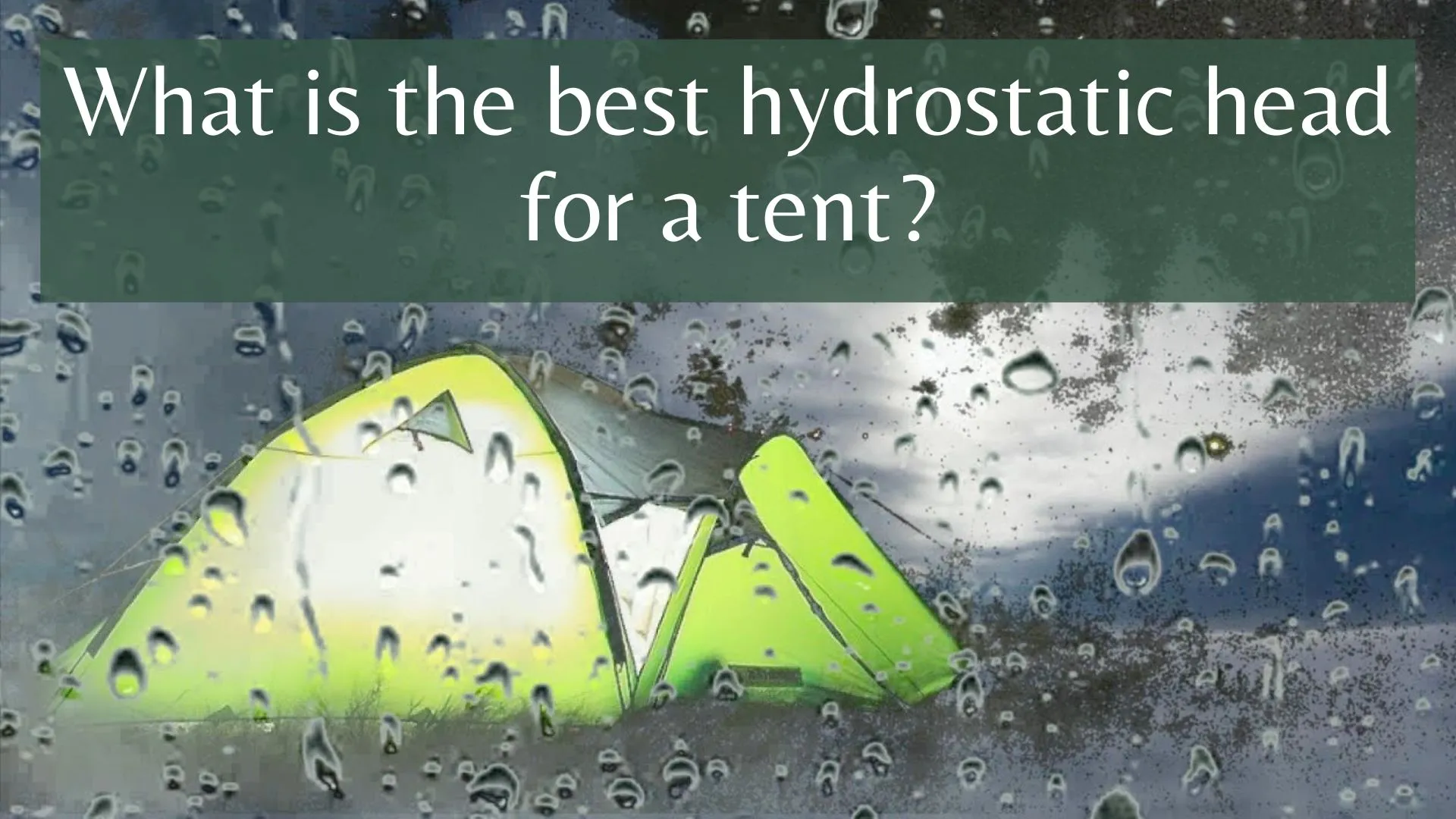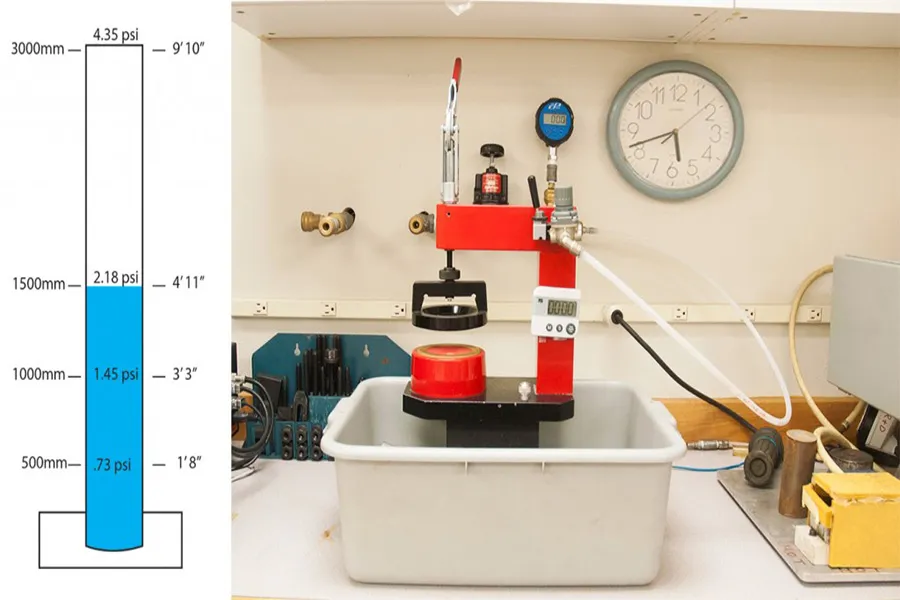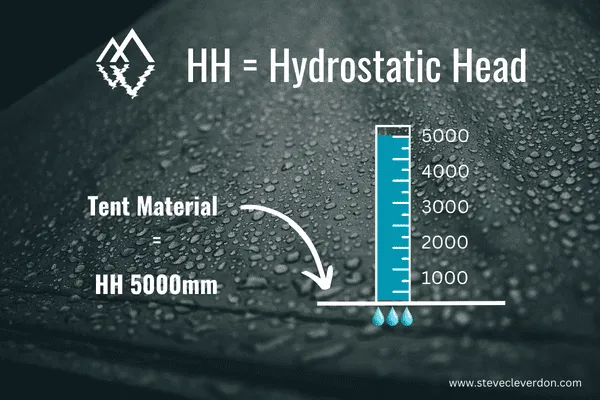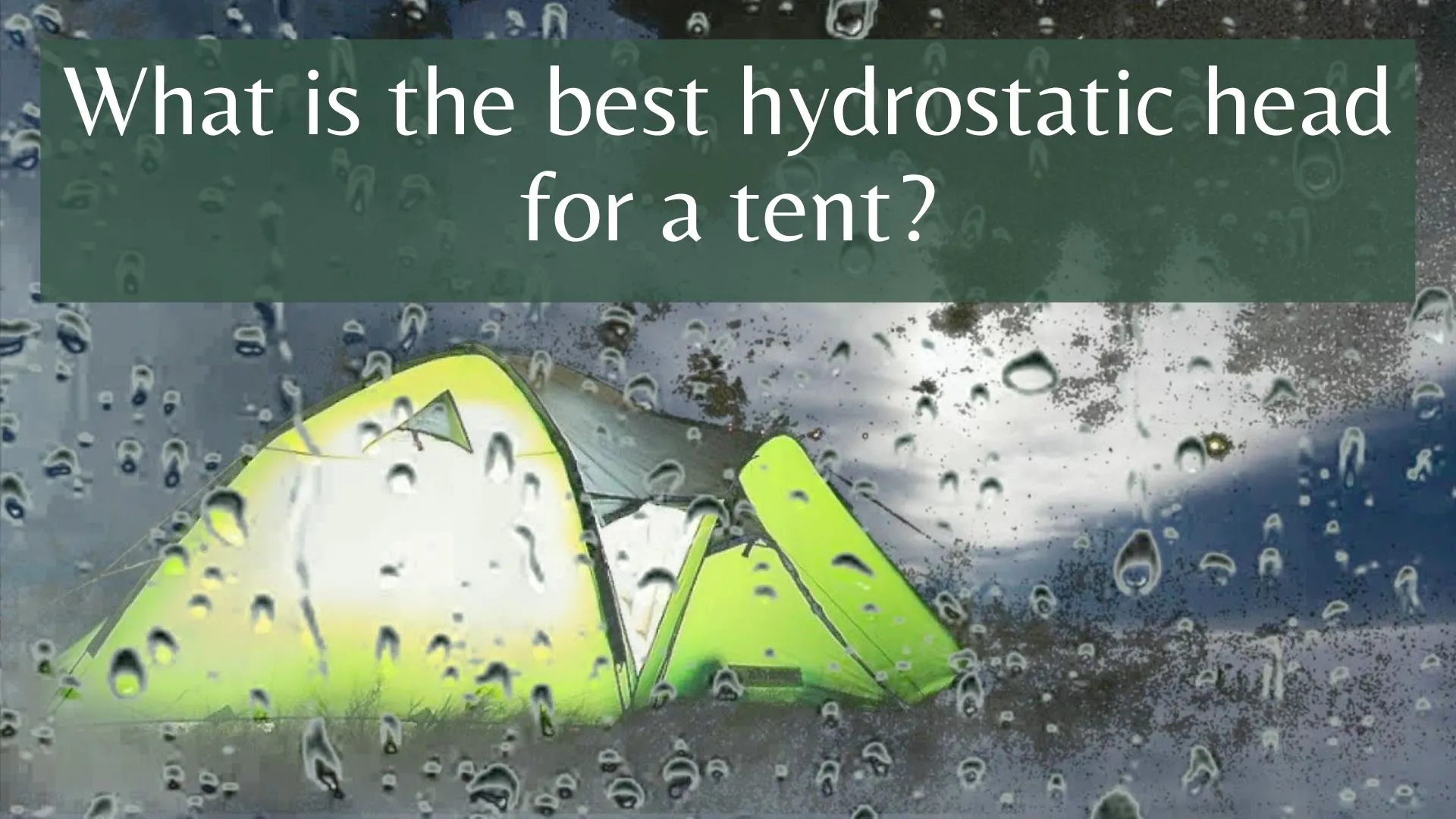Understanding Hydrostatic Head: The Science Behind Waterproofing
Key Insight: A 3000mm hydrostatic head rating means the fabric can withstand a column of water 3000mm (3 meters) tall before water starts to penetrate through the material.

When I first encountered the term "hydrostatic head" during my early camping days, I was completely confused. After years of testing various tents and jackets in different weather conditions, I can confidently explain how waterproof is a 3000mm hydrostatic head rating. The hydrostatic head measurement is essentially a pressure test that determines how much water pressure a fabric can withstand before it starts to leak.
The testing process involves placing a fabric sample under a clear tube and gradually filling it with water. The height at which water begins to penetrate the fabric is measured in millimeters, giving us the hydrostatic head rating. For a 3000mm hydrostatic head rating, this means the fabric can resist water pressure equivalent to a 3-meter-tall column of water pressing down on it.
Understanding what is a good hydrostatic head is crucial for making informed decisions about outdoor gear. In my experience camping across various climates, from the Pacific Northwest's persistent drizzle to sudden mountain thunderstorms, the hydrostatic head rating has proven to be a reliable indicator of a tent's waterproof capabilities.
The Physics Behind Water Pressure
From a scientific perspective, water pressure increases with depth due to gravitational force. Each millimeter of water height creates a specific amount of pressure on the fabric surface. This principle applies whether you're dealing with rainwater hitting your tent or water pressure from wet ground conditions. The 3000mm rating provides a standardized way to compare different fabrics and predict their performance under various water pressure scenarios.
Pro Tip: Understanding what is meant by hydrostatic head helps you interpret manufacturer specifications and make better gear choices based on your specific camping conditions.
How Waterproof is a 3000mm Hydrostatic Head in Real-World Conditions
After testing numerous tents with 3000mm hydrostatic head ratings across different weather conditions, I can provide you with practical insights about their performance. How waterproof is a 3000mm hydrostatic head in actual camping scenarios? The answer depends on several factors, but generally, it provides excellent protection for most camping situations.
Light to Moderate Rain
A 3000mm hydrostatic head performs exceptionally well in light to moderate rainfall. During my camping trips in the UK and Pacific Northwest, tents with this rating consistently kept me dry during typical rain showers lasting several hours.
Heavy Rain & Storms
In heavy rain conditions, 3000mm hydrostatic head rating still provides good protection, though wind-driven rain can create additional challenges. Proper tent setup and seam sealing become crucial factors in these conditions.
Based on my field testing, how waterproof is a 3000mm hydrostatic head rating translates to reliable protection in most camping scenarios. I've used tents with this rating during week-long backpacking trips in Scotland's unpredictable weather and found them more than adequate for typical outdoor adventures.
Recommended 3000mm Waterproof Tents
When evaluating how waterproof is a 3000mm hydrostatic head rating, it's important to consider that this measurement represents laboratory conditions. Real-world performance can vary based on fabric age, seam construction, and environmental factors. For more specific guidance, check out what is a good hydrostatic head rating for a tent to understand different rating requirements for various camping scenarios.
Testing Methods and Standards for Hydrostatic Head Measurements
Understanding how manufacturers test hydrostatic head ratings helps explain why a 3000mm rating provides consistent results across different brands. The testing process follows standardized procedures that ensure reliable comparisons between products. Having visited several textile testing facilities and spoken with manufacturers, I can explain the rigorous process behind these measurements.

Standard Testing Equipment and Procedures
The hydrostatic head testing uses specialized equipment like the Suter Tester or water column method. Both approaches measure the exact point where water begins to penetrate the fabric under controlled conditions. The process involves clamping a fabric sample and gradually increasing water pressure until the first drops appear on the opposite side.
Testing Protocol Steps:
- Fabric sample preparation and conditioning
- Secure mounting in testing apparatus
- Gradual water pressure application
- Measurement at first water penetration point
- Recording of hydrostatic head value in millimeters
When considering how waterproof is a 3000mm hydrostatic head rating, it's crucial to understand that these tests occur under controlled laboratory conditions. Temperature, humidity, and fabric tension all influence the results. This standardization ensures that a 3000mm rating from different manufacturers represents comparable waterproof performance.
The testing standards also specify that measurements should be taken at multiple points across the fabric sample to ensure consistency. This explains why reputable manufacturers can confidently state their hydrostatic head ratings and why these numbers serve as reliable indicators of waterproof performance across different brands and products.
Tent vs Jacket Waterproofing: Different Standards for Different Gear
One of the most important insights I've gained from testing various outdoor gear is that hydrostatic head requirements differ significantly between tents and jackets. How waterproof is a 3000mm hydrostatic head rating varies greatly depending on the application and the specific pressures each type of gear experiences during use.
Tent Waterproofing
For tents, 3000mm hydrostatic head provides excellent protection for most camping scenarios. The fabric experiences primarily vertical water pressure from rain, making this rating highly effective.
- Suitable for 3-season camping
- Handles moderate to heavy rain
- Good for weekend trips and extended camping
Jacket Waterproofing
Jackets with 3000mm hydrostatic head offer basic waterproof protection but may not be sufficient for prolonged exposure to heavy rain or high-activity situations.
- Light to moderate rain protection
- Suitable for short-term exposure
- May require higher ratings for active use
The difference in requirements stems from how each type of gear is used. Tents remain stationary and primarily face downward water pressure, while jackets must handle movement, flexing, and various angles of water contact. For detailed guidance on jacket waterproofing, explore what is a good hydrostatic head rating for a jacket.
Essential Waterproofing Accessories
Understanding how waterproof is a 3000mm hydrostatic head rating for different gear types helps you make informed purchases. While this rating provides excellent tent protection, jacket users might need higher ratings (5000-10000mm) for extended outdoor activities or professional use in harsh conditions.
Factors That Affect Real-World Waterproof Performance
While understanding how waterproof is a 3000mm hydrostatic head rating is important, real-world performance depends on numerous factors beyond the basic rating. Through my extensive field testing and conversations with gear manufacturers, I've identified several critical elements that influence actual waterproof performance.

Seam Construction and Sealing
Even with a perfect 3000mm hydrostatic head rating, water can still penetrate through poorly constructed or unsealed seams. During my camping experiences, I've learned that seam quality often determines real-world waterproof performance more than the fabric rating itself. Taped seams, welded seams, and seam sealant application all play crucial roles in maintaining waterproof integrity.
Common Failure Points
- Untreated seams allowing water penetration
- Zipper areas without proper weatherproofing
- Fabric aging and coating degradation
- Mechanical stress causing fabric failure
Wind-driven rain creates additional challenges that standard hydrostatic head testing doesn't fully capture. During storms, rain doesn't fall straight down but hits fabric at various angles with increased force. This explains why tents with 3000mm ratings might experience moisture ingress during severe weather conditions, even though they theoretically should handle much higher water pressure.
Fabric Age and Degradation
How waterproof is a 3000mm hydrostatic head rating changes over time as fabric and coatings age. UV exposure, repeated folding, and chemical exposure gradually reduce the waterproof effectiveness. In my experience, most tent fabrics maintain their rated performance for 50-100 nights of use, depending on storage conditions and care practices.
Maintenance Tips for Optimal Performance
- Store tents completely dry to prevent mold and coating damage
- Reapply seam sealant every 20-30 camping trips
- Avoid prolonged UV exposure when possible
- Use appropriate cleaning products designed for technical fabrics
The DWR (Durable Water Repellent) coating on fabric surfaces also significantly impacts performance. While not directly related to hydrostatic head ratings, DWR helps water bead and roll off fabric rather than soaking in. When DWR fails, fabric becomes saturated and feels "wet" even if the underlying waterproof membrane remains intact.
Choosing the Right Waterproof Rating for Your Needs
After years of testing gear in various conditions, I can confidently guide you on when a 3000mm hydrostatic head rating is appropriate and when you might need different specifications. Understanding how waterproof is a 3000mm hydrostatic head rating for your specific use case ensures you make the right gear investment.
Waterproof Rating Recommendations by Activity
3000mm: Perfect For
- Weekend camping trips
- 3-season tent use
- Moderate rain conditions
- Family camping
5000mm+: Better For
- Extended expeditions
- High-precipitation areas
- Professional outdoor work
- Winter camping
10000mm+: Essential For
- Extreme weather conditions
- Mountain climbing
- Arctic expeditions
- Commercial applications
For most recreational campers, understanding how waterproof is a 3000mm hydrostatic head rating reveals that this specification provides excellent value and performance. During my camping adventures across different climates, from Scottish highlands to American national parks, 3000mm-rated tents consistently kept me dry and comfortable.
Premium Waterproof Gear Selection
Consider your typical camping conditions when evaluating whether a 3000mm hydrostatic head rating meets your needs. If you primarily camp in established campgrounds during fair weather, this rating provides more than adequate protection. However, if you frequently encounter severe weather or camp in exposed locations, higher ratings offer additional peace of mind.
Remember that waterproof ratings represent just one aspect of gear performance. Factors like tent design, ventilation, ease of setup, and overall construction quality significantly impact your camping experience. For comprehensive information about this topic, visit our complete guide on 3000mm hydrostatic head waterproofing.
Conclusion
So, how waterproof is a 3000mm hydrostatic head? Based on my extensive field testing and analysis, it provides excellent waterproof protection for most camping and outdoor activities.
Throughout this comprehensive guide, I've shared practical insights gained from years of testing gear in various weather conditions. A 3000mm hydrostatic head rating offers reliable protection against moderate to heavy rain, making it an excellent choice for three-season camping, weekend trips, and family outdoor adventures.
The key takeaway is that while hydrostatic head ratings provide a valuable benchmark for comparing gear, real-world performance depends on multiple factors including seam construction, fabric age, maintenance practices, and environmental conditions. Understanding these variables helps you make informed decisions about your outdoor gear investments.
For most recreational campers and outdoor enthusiasts, a 3000mm hydrostatic head rating represents the sweet spot between performance, weight, and cost. It provides sufficient protection for typical camping scenarios while remaining accessible and practical for regular use.
As you continue your outdoor adventures, remember that the best waterproof rating is one that matches your specific needs and camping conditions. Whether you're planning a weekend camping trip or an extended backcountry expedition, understanding how waterproof is a 3000mm hydrostatic head rating empowers you to choose gear that will keep you dry and comfortable throughout your outdoor experiences.
Ready to Upgrade Your Camping Gear?
Explore our recommended 3000mm waterproof tents and accessories to enhance your outdoor adventures.
Shop 3000mm Waterproof TentsHappy camping, and may your adventures stay dry!


